In Belfort, only two things are guaranteed in life…
…Gnomes and Taxes.
Put your Elves, Dwarves and Gnomes to work in the Village and Guilds of Belfort to collect resources and build up the city!
Elves collect wood from the forest while Dwarves collect stone from the quarry. An Elf and a Dwarf together can collect Metal from the mines, and either one can collect Gold. Build buildings in the five districts of the pentagonal city and hire Gnomes to run them to gain their special abilities.
Belfort is a worker placement game with area majority scoring in each district as well as for each type of worker. Buildings give you influence in the districts as well as income, but taxes increase based on your score so the winning players will have to pay more than those behind! Manage your resources and gold well, choose your buildings wisely, and help build the city of Belfort!
A lot is made of Zombie, Cthulu and other overdone themes. Even though proof that Trains and other themes dominate them in a head count. Also, there’s usually chatter of ‘another’ deck-building game being made. These stand out by name as “XYZ the Deck Building Game” wouldn’t ever be called “XYZ the Worker Placement Game”.
So while I’ve played quite a few Train and Zombie Games, and even more Worker Placement games, it tells me they need to stand out.
So this tells me two things…
1 – A Fantasy themed game needs to have something to make it stand out
2 – A Worker Placement game needs to have something different.
The Game
Belfort is a Fantasy themed worker placement game (unique mix) with an area control element (new to me) and a very well laid out play area. (always nice) It’s bright, it’s colourful, it’s… pentagonal.
Yes, it’s a game where you place workers to get resources to buy stuff to score points but there’s plenty more to it.
You start with 3 square Dwarves, 3 round Elves, (yes the shapes are important) 5 gold and 1 each of Wood, Stone and Metal. Your player board tells you your starting stuff, as well as pretty much everything else you need to know. Having the round summary, scoring reminder and a list of EVERY building you can build right in front of you is great. Minimising the passing of a rulebook, asking of a question and general remembering of a thing speeds the game up a lot.
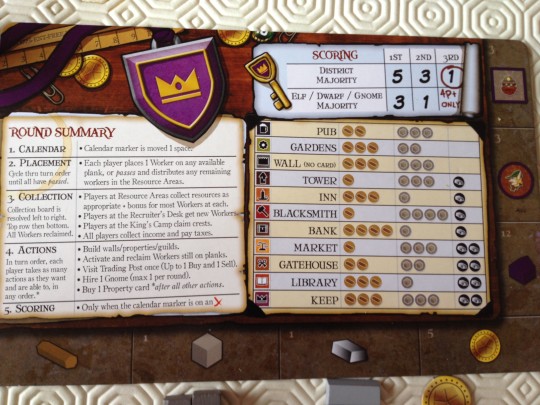
Calendar
The first thing you do each turn is to move the calendar marker on a turn. This marks which of the 7 turns you are on. This is marked on a ‘clipboard’ which fits into the theme of the game very well. It adds to the ‘worker’ feel and the humorous text adds to the feel of this weird yet sensible world.
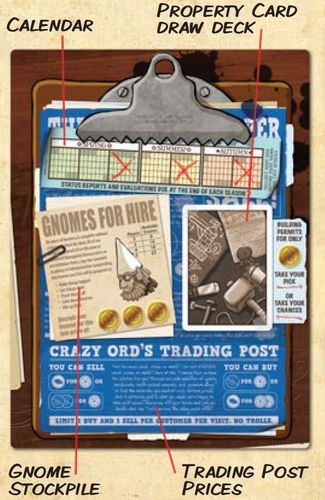
Calendar Board Image from BGG
The board also helps you store the Gnomes and Building cards which is great as the game could start to dominate all tablespace with 5 players.
Worker Placement
Next is the familiar ‘placement phase’. One of the many things I like about this game is that the placement and action phases are different so it gives you an extra layer to think about. In turn order, you take turns playing your workers onto ‘Planks’. These are squares that only Dwarves can use and circles only Elves can use or a circle within a square that either can use.
These are communal ‘fight for it’ type spaces which can alter turn order, recruit workers or activate a Guild building on the main city board. The Guilds change game to game and can drastically change the way everyone plays.
When you finish ‘Planking’ you ‘Pass’ and stick all of your remaining workers you wish to use in the Woods and Mines and get them to gather resources. This is on the collection board and again uses the different types of workers. Elves get Wood (giggle), Dwarves Stone, a combination of one of each gets Metal and either can gain a gold.
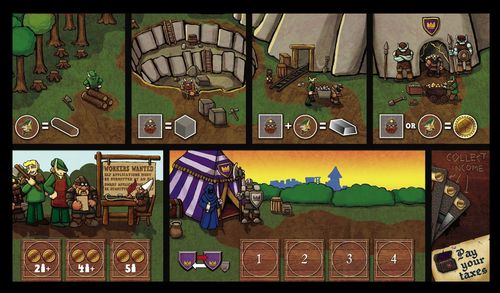
Collection Board Image from BGG
Resolution
The board is resolved with the player having a majority for each resource getting an extra one. This means passing last gives you an edge in this respect. When switching player order, it resolves in the order the characters were placed in the Kings camp. You switch your turn order shield with the player of your choice then turn it face down to show no one else can steal it.
I find this interesting that turn order can change between placing workers and activating them. Again, another lair in the game.
Now you collect income and pay taxes. Income is on your buildings, simple. But tax is a very nice thing that happens in this game. The Pentagonal board has 10 sides used as a scoring track. As you gain points you move around these 10 edges of the board. the more you score, the more taxes you pay. It slows down a runaway leader in a similar way to Suburbia.
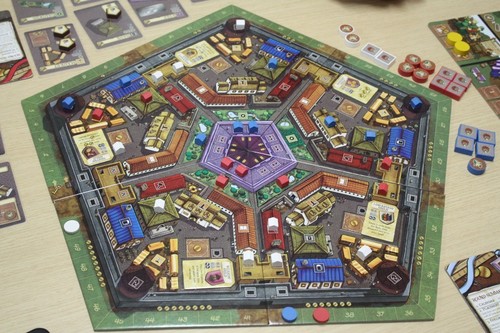
City Board Image from BGG
Actions
Finally, we get to takes our actions. In the newly established turn order, you can take all your actions. Take your Planked workers back to your supply to take action in any order you like. You can buy a resource from the Trading Post, and sell one once per turn. You can buy a property card from the supply.
The other thing you can do is build a building form your hand, and/or buy a gnome. Buildings are built by trading in resources. Buildings have abilities which you an use in the action phase but more importantly they let you but a building on the city board. Putting the building on the corresponding icon on the board in one of the 5 city segments is the ‘area control’ aspect of the game. You’re looking to have the most buildings in each segment to score as many points as possible.
Gnomes are used to unlock building abilities, check these two buildings out I built.
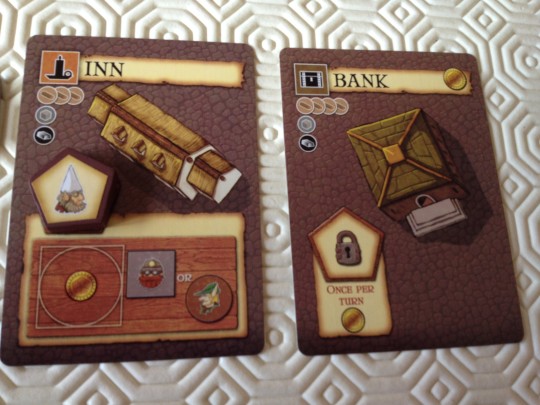
The Inn on the left lets you use an Elf or Dwarf and pay one gold to hire a Dwarf or Elf. The pentagonal Gnome token was used to unlock this ability.
The bank, which gives you one gold per turn, has a padlock icon in an empty pentagonal shape. Once a Gnome is purchased and added I would be able to use this ability.
Scoring occurs on the 3rd, 5th and final rounds. You score points for majorities in each city segment and whoever has the most Dwarves, Elves and Gnomes.
Most points wins.
Belfort Summary
I like this, especially in comparison to other worker placement games.
Lords of Waterdeep is less dimensional.
Euphoria is a better game, but more of a race than a standard Euro.
Village offers more for me, there’s more going on.
The cuteness factor helps me with Belfort. I like the humour, the cute/chunky components and the nice overall look of the game.
One I would play again, and maybe one you need to play again to fully understand. The buildings, gnomes and resource management as well as the area control aspect gives you plenty to think about.
Looking forward to a second play.
Jesta ThaRogue
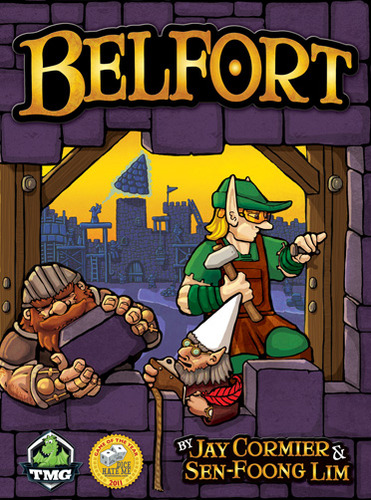


Leave a Reply